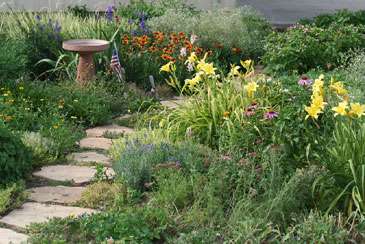Landscaping with a Green Thumb: The Ornamental Garden

In this article, you will find:
Choose easy flowering plants
Flowering Plants: Bulbs and PerennialsIf you long for a garden filled with flowers, choose dependable bulbs such as crocuses, daffodils, Asian lilies, and allium, and hardy perennials that need very little division or deadheading.
Division is called for when a perennial has grown into a wide clump and its center begins to die. For a number of perennials, that's about every three years. Division keeps the plants vigorous and blooming, with the bonus that you end up with more plants. However, division also takes time and physical effort. Deadheading is another time-consuming task you may want to avoid. It refers to the practice of removing spent flowers from a plant to keep it from putting its energy into producing seeds—which causes flowering to decline.
Perennials such as ornamental grasses, fringed bleeding heart, echinacea, lady's mantle, peonies, hostas, daylilies, and astilbe need minimal attention and can even withstand the occasional drought. Think in terms of native plants, and you'll save yourself a ton of work and keep your water usage low.
Many people feel that their garden is incomplete without roses. Unfortunately, most roses are extremely labor-intensive, requiring pruning, deadheading, and lots of water and fertilizer to bloom properly. They also can be a magnet for pests and diseases, jeopardizing other plants that share the same bed. If you can't live without roses, try ultra-hardy rugosa roses. Rugosas are very fragrant, disease-resistant, drought-tolerant, and winter hardy. They do not like or need to be sprayed with chemicals, so they are the perfect addition to the organic garden.
When you plant, group similar species together, and try to plant multiples of three. As the blooming season progresses, you will have sequential blocks of color, rather than spotty blooming here and there in the garden.
The best thing you can do for your perennial plants is give them compost—create it yourself or buy it bagged from a nursery. Mix it into the soil well when planting; lightly mix it into the top of the soil around established plants yearly, and make a compost tea to use as a liquid fertilizer. Mulch the bare areas of garden beds well to keep the soil moist and discourage weeds.
A number of natural fertilizers will encourage more blooms, including seaweed, manure, guano, and fish extract. These types of fertilizers are usually applied to the soil in the form of "tea."
Flowering Plants: Annuals and Container Gardening
Plant a dependable perennial, and it will return bigger and better every year. But perennials only bloom for a short time each season. Many annuals bloom from spring to the first frost—and that is their main appeal. The drawback is that they must be purchased as seedlings or started from seed each year and then planted, making them fairly labor- and energy-intensive.
Rather than planting entire beds with annuals, take the low-maintenance approach. Use them in only a few prominent spots, where they can be seen frequently and up close, and will be most appreciated. For example, plant them near your front door or deck, or in a couple of window boxes. Or consider planting annuals in a few large, decorative planters. Container gardening has a number of advantages. You have full control over the soil content, and watering and fertilizing a planter is far easier than an entire bed. The container itself can be ornamental, and it raises the flowers up closer to the eye. You can move containers around as you like—clustering them in an area temporarily for an outdoor party, or moving them around the yard to perennial beds that are no longer blooming.
If you want to try container gardening, use the largest pots you can manage. The smaller the pot, the more quickly the soil dries out and needs watering. You may want to look for the new resin pots that are on the market—they're much lighter than clay pots and the soil doesn't dry out as quickly. It's best to purchase a container mix instead of using soil from your garden. The mix will be free of pests and weed seeds, and won't compact the way garden soil does. Before planting, mix some polymer crystals (available at most nurseries and home supply centers) into the potting medium. These crystals absorb several hundred times their weight in water and release the moisture as the soil dries out.
Entire books have been written about the art of container gardening, but the classic, basic planting method calls for one or more tall plants in the center, surrounded by colorful flowering plants, and a trailing plant at the edges.
Related articles:
The Organic Lawn
The Vegetable Garden
Composting

